Journal of the NACAA
ISSN 2158-9429
Volume 4, Issue 2 - November, 2011
Effect Of 30-Second Dry Ice and 20-Second Liquid Nitrogen On Beef Cattle Freeze Branding
- Wilson, T.W., County Extension Director/Livestock and Forages Agent, University of Florida IFAS Extension
Dollar, M.A., County Coordinator/Agriculture & Natural Resources Agent, University of Georgia Cooperative Extension
Worley, P.C., Superintendent, Northwest Georgia Research and Education Center
ABSTRACT
Animal identification is necessary to maintain production records and is useful in making management decisions related to your herd. Angus heifers were divided into two treatments; dry ice (DI; n = 20) or liquid nitrogen (LN; n = 20) to evaluate the effects of two commonly used freeze branding techniques. Two complete sets of 4-inch copper alloy branding irons were submerged in separate cooling solutions. Branding location was cleaned of debris and clipped using surgical clippers. Dry ice (DI) heifers were branded for 30 seconds with branding irons cooled using a solution of dry ice blocks (20 lbs) and pellets (5 lbs) that were mixed with approximately 2.5 gallons of 99% isopropyl alcohol. Liquid nitrogen (LN) heifers were branded for 20 seconds with branding irons cooled with liquid nitrogen. Four months after branding, brand quality was evaluated by averaging a numerical score assigned by two observers using a brand readability scale (
Introduction
Freeze branding was first used in the northwestern United States in the 1960’s and can be used as an alternative to fire branding (Lay et al., 1992a). Techniques used to apply freeze brands have changed little since it was first established; however, the readability of the brand may vary depending on the cooling solution used and the length of time that brands are applied. Two commonly used cooling solutions inlcude dry ice and 99% alcohol (DI) and liquid nitrogen (LN). The length of time for brand application for DI has been reported to vary from 25 to 60 sec. and LN from 15 to 35 sec. (Parrish, 2006; Hall et al., 2009).
Beef cattle hides can be used to produce items such as foot wear, hand bags and covering for car seats. Damage to hides due to fire branding often reduces their value and potential use. Freeze branding reduces hide damage (Lay et al., 1992b) and reduces blotching compared to fire branding. However, if freeze branding irons are applied for approximately 60 sec., a bald or bare brand can occur (Parrish, 2006). Research has shown that freeze branding, although not pain free to the animal, is less painful for cattle than fire branding (Lay et al., 1992b, Schwartzkopf-Genswein et al., 1997). Although costs and time associated with freeze branding are higher than fire branding, managers who use them will reduces stress while on the animal while providing an easy-to-read and long lasting brand.
Due to the variability in brand readability based on freeze branding technique, the objective of this project was to compare two commonly used methods of applying brands.
Material and Methods
This project was approved by the University of Georgia Institutional Animal Care and Use Committee (IACUC) # A2007-10056-0.
Forty nulliparous Angus heifers were divided into one of two groups: 1) dry ice/isopropyl alcohol (n=20; DI) or 2) liquid nitrogen (n=20; LN).
Freeze brand readability can be affected not only by the procedure in which it is applied, but also by weather conditions. Increased humidity and wind speed can affect the temperature of cooled branding irons. To compare weather conditions, an average time of day was determined for heifers branded in the AM (10:36 am) and for the PM (2:28 pm). Humidity and wind speed were different from the AM and the PM (Table 2). Half of each group was branded in the morning and the other in the afternoon. All heifers were maintained under shade in both the AM and PM. After branding, all the animals were maintained on 35 acre Bermudagrass/Fescue pastures and provided free choice access to costal bermudagrass hay, mineral and water.
Weather measurements including humidity, wind speed and temperature on the day of branding were obtained from the Georgia Automated Environmental Monitoring Network (www.georgiaweather.net) weather station located at the University of Georgia Red Bud Farm (100 yards from the branding site).
Complete sets of 4-inch copper alloy branding irons were submerged in either the DI or LN solutions for approximately 25 minutes before cattle were handled so that irons could cool. Since DI and LN will evaporate, additional DI and LN were provided in the PM to maintain coolant levels. In this project, only one “S” brand was used to identify the birth year. This iron was cooled using liquid nitrogen regardless of treatment.
Preparation
Heifers receiving the dry ice (DI) treatment were branded for 30 seconds with branding irons cooled using a solution of dry ice blocks (20 lbs) and pellets (5 lbs) that were mixed with approximately 2.5 gallons of 99% isopropyl alcohol (Figure 1). Liquid nitrogen (LN) heifers were branded for 20 seconds with branding irons cooled in a liquid nitrogen solution (Figure 2).
Procedure
- Each heifer, regardless of treatment was restrained in a squeeze chute while brands were applied.
- The brand location was brushed free of debris using a rice comb and the hair was clipped using trimmers equipped with surgical blades (Figure 3).
- After clipping, the brand location was brushed free of debris and loose hair a second time and the site was liberally saturated until dripping with 99% isopropyl alcohol using a spray bottle.
- Two brands were applied at one time by two different individuals (Figure 4).
- After branding, the irons were cleaned of any debris and re-submerged into their respective solutions.
Irons were allowed to cool for a minimum of 3 minutes before they were used a second time. This procedure was performed on all heifers regardless of treatment.
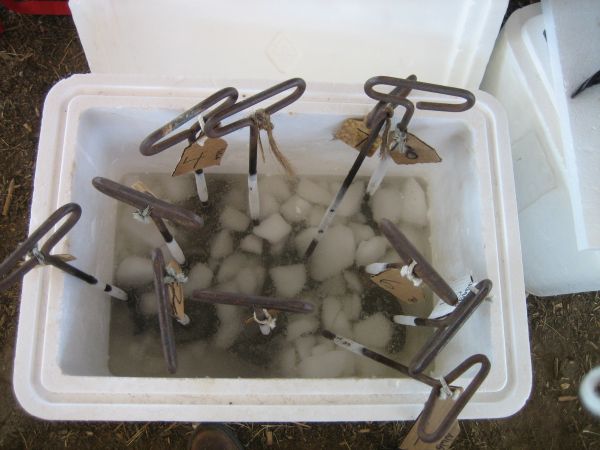
Figure 1 Dry ice and alcohol solution
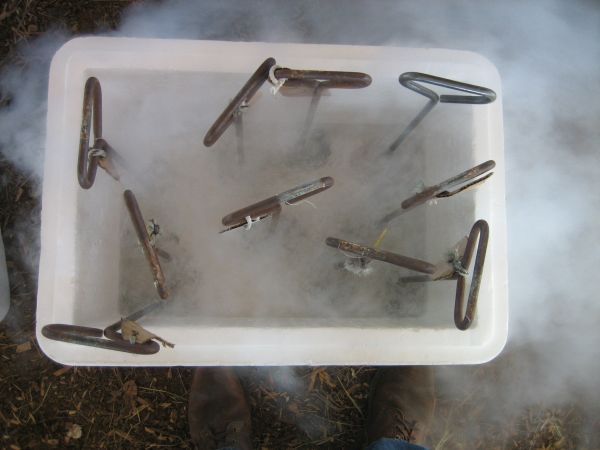
Figure 2 Liquid nitrogen solution
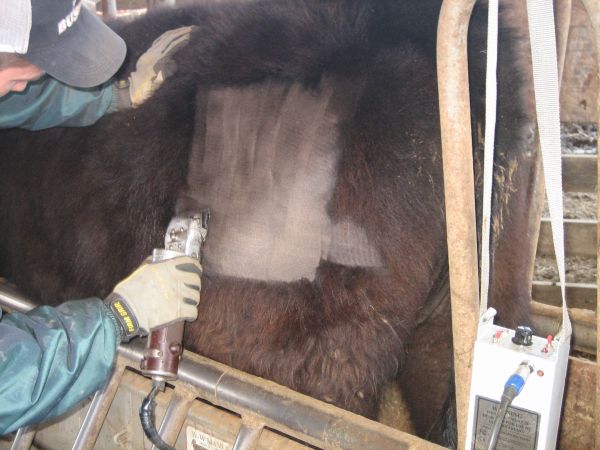
Figure 3 Clipping brand location
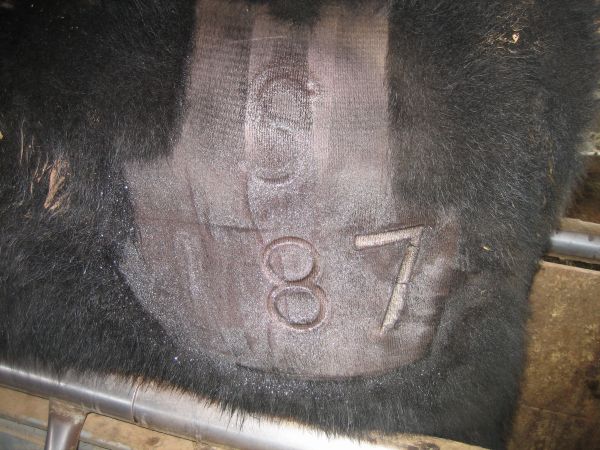
Figure 4 Branding site
Heifers were evaluated approximately four months after the brands were applied to determine brand quality (Figure 5). Brand quality was determined by averaging a numerical score assigned by two trained observers from a brand readability scale (
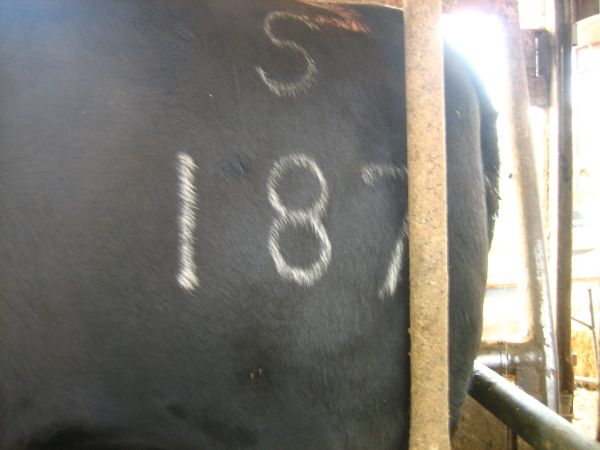
Figure 5 Brand evaluation
| Table 1 - Score and description of the Brand Readability Scale | ||||
| Score | Visual | Description | ||
| 1 | Non-readable | Black/red brand may be read up close or not at all | ||
| 2 | Non-readable | Excessive amount of black/red hair in brand | ||
| 3 | Readable | White hair slightly visible, but a lot of black/red hair in brand | ||
| 4 | Readable | White hair visible, but some black/red hair in brand | ||
| 5 | Readable | White hair very visible | ||
| Table 2 - Weather Conditions at Brand Application | |||
| AM | PM | ||
| Time of Day (avg.) | 10:36 AM | 2:28 PM | |
| Humidity (%) | 61 | 39 | |
| Wind Speed (m/s) | 3.35 | 4.18 | |
Results and Discussion
During branding, it was observed that the amount of time required to apply each freeze brand method was different. From the moment the heifer entered the chute until she was released, freeze branding using DI took approximately six minutes whereas LN took approximately five minutes. Humidity from 10:36 AM to 2:28 PM (difference of 3 hours and 52 minutes), although not significant, decreased 22 % and wind speed increased 0.83 m/s (Table 2).
The branding method X time of day interaction was not significant for brand readability after 127 days (P=0.10). Mean BRS were 2.3 and 3.9 for branding LN and DI, respectively and was significantly higher for DI. Differences in mean BRS for animals branded in the morning (2.94) and in the afternoon (3.22) were not significant.
Because of the BRS used readings of 1-2 were not readable and 3-5 were readable, a mean BRS of 2.5 was used as a cut-off for determining group readability. Mean BRS were overall readable for animal branded in both the AM and PM with DI
Brand readability could be affected based on the method of freeze branding or the weather condition at the time the brand was applied. Based on the described protocol, freeze branding with DI resulted in a better
Conclusion
This study indicates that freeze branding quality can be influenced by weather and method of application. However, according to the methods described in this demonstration, DI freeze branding for 30 sec., regardless of the reported weather conditions, resulted in brands that were easier to read when compared to LN freeze branding for 20 sec. Although freeze branding with DI using the protocol described above takes more time and materials can be more expensive, this method can provide an easy-to-read brand while reducing stress to the animal.
Acknowledgments
The author would like to thank the following for assisting in the research described in this manuscript: E. Simonne, T. D. Bagwell, T. D. Turnquist and G. W. Rawls.
Literature Cited
Hall, J.B, S.P. Griner and C. Gregg. 2009. Cattle identification: freeze branding. Virginia Cooperative Extension Fact Sheet 400-301. Virginia Polytechnic Institute and State University.
Lay, D. C., Jr., T. H. Friend, R. D. Randel, C. L. Bowers, K. K. Grissom, and O. C. Jenkins. 1992a. Behavioral and physiological effects of freeze or hot-iron branding on crossbred cattle. J. Anim. Sci. 70:330-336.
Lay, D. C., Jr., T. H. Friend, C. L. Bowers, K. K. Grissom, and O. C. Jenkins. 1992b. A comparative physiological and behavioral study of freeze and hot-iron branding using dairy cows. J. Anim. Sci. 70:1121-1125.
Parrish, J. 2006. Freeze branding basics. Cattle Business in Mississippi. Mississippi Cattlemen’s Association. (http://msucares.com/livestock/beef/mca_may2006.pdf).
Schwartzkopt-Genswein, K. S., J. M. Stookey, and R. Welford. 1997. Behavior of cattle during hot-iron and freeze branding and the effects on subsequent handling ease. J. Anim. Sci. 75:2064-2072.
